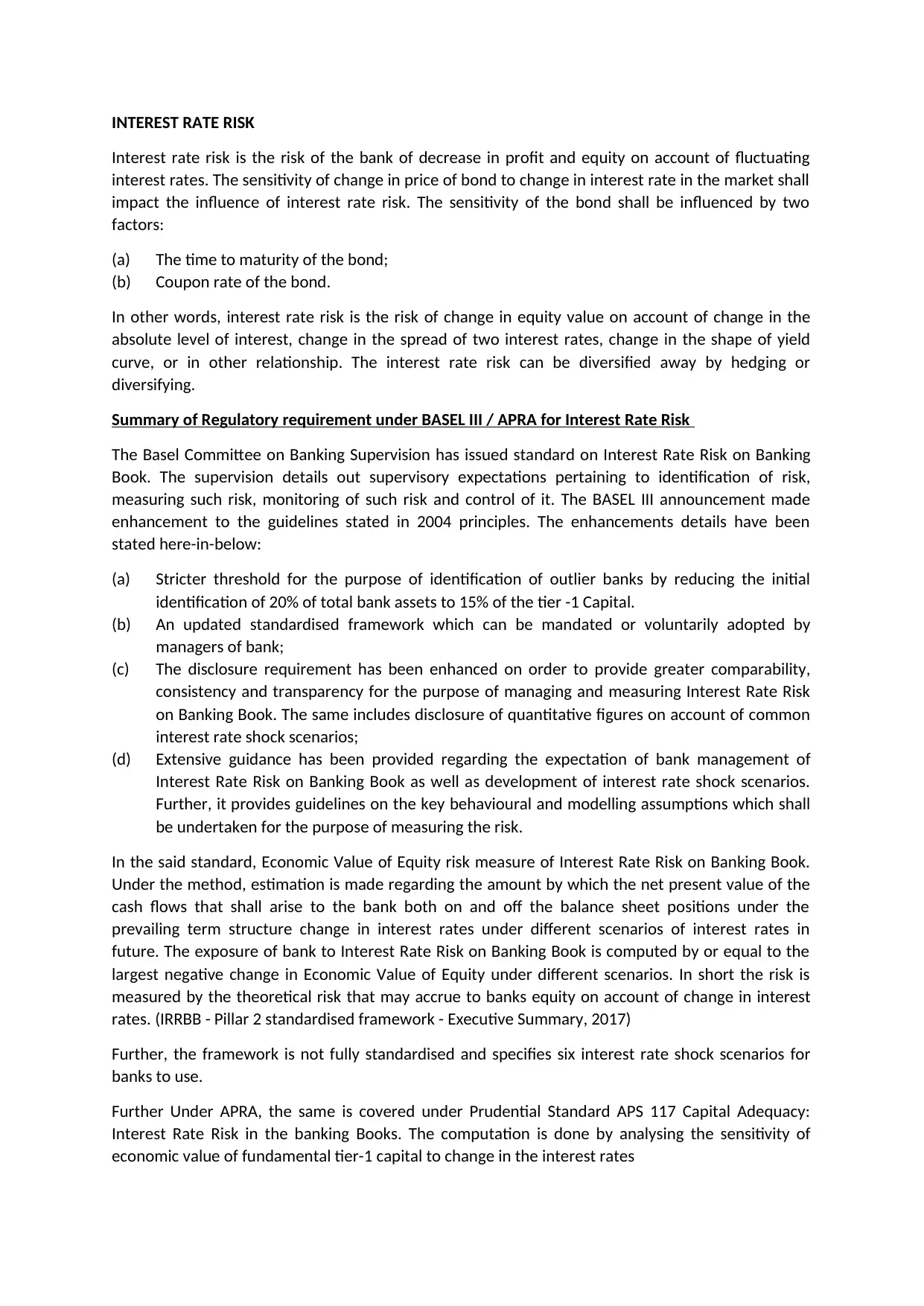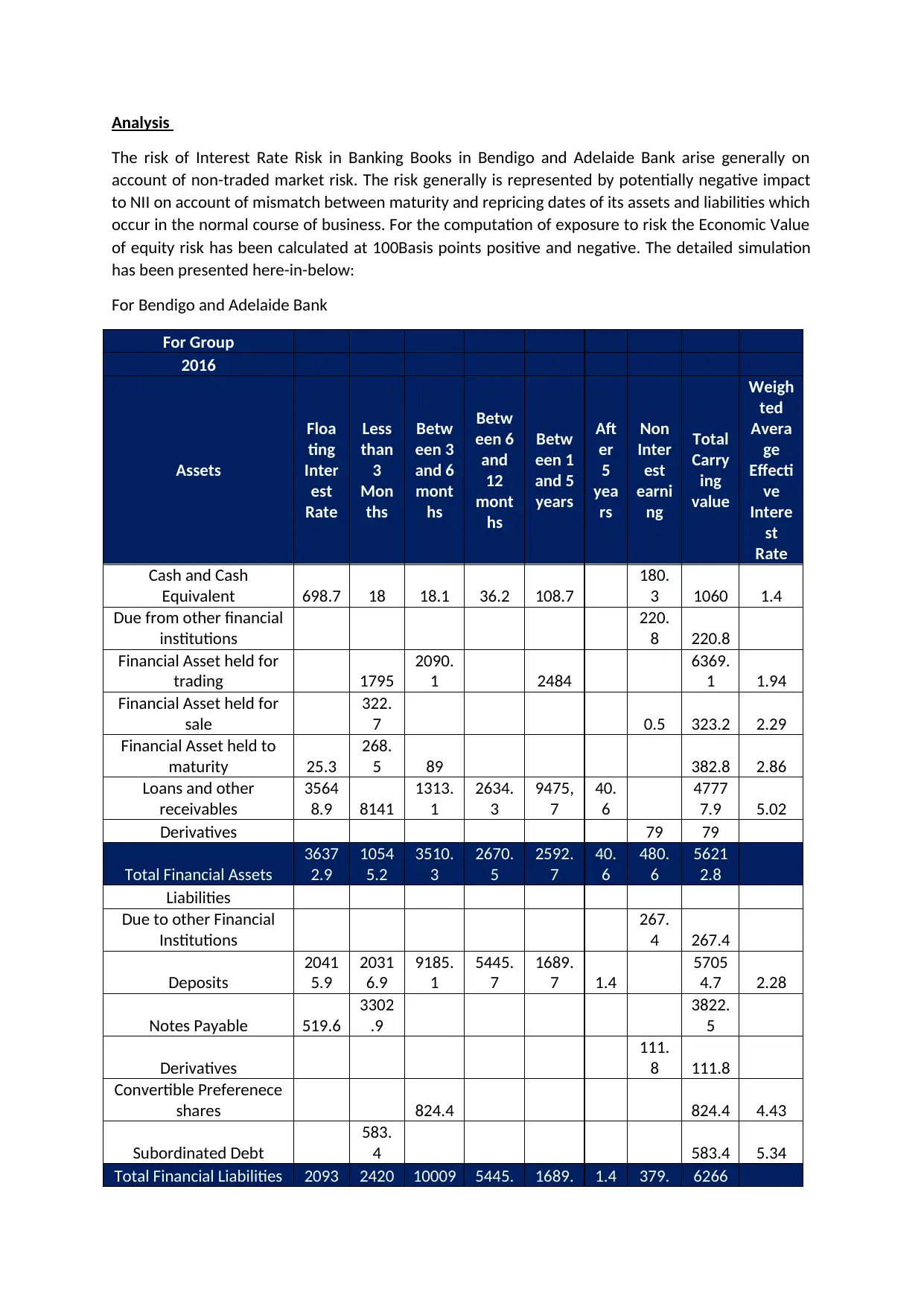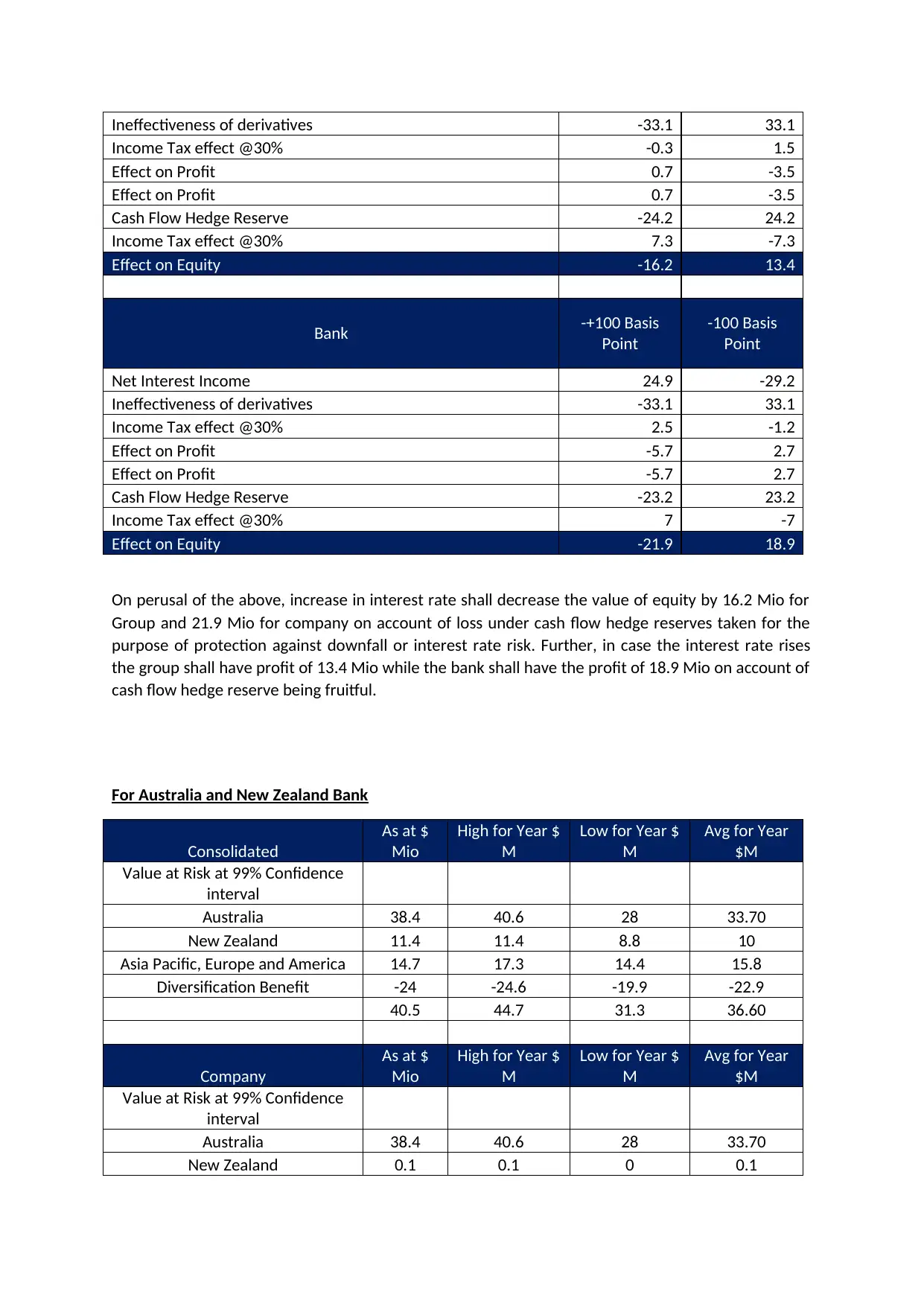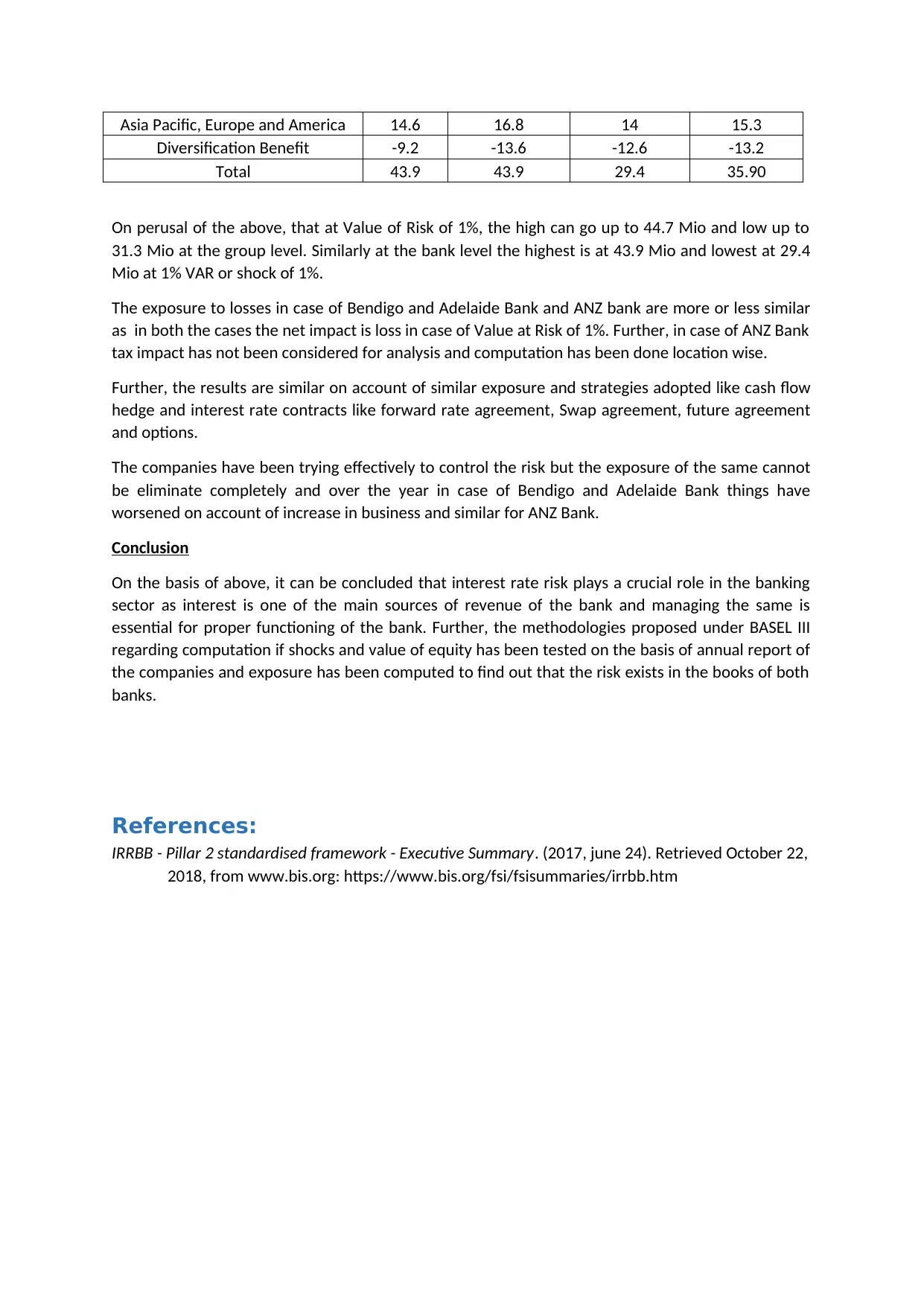Interest Rate Risk Analysis: Bank Comparison Report
VerifiedAdded on 2023/06/03
|5
|1833
|237
Report
AI Summary
This report provides a detailed analysis of interest rate risk within the banking sector, focusing on the impact of fluctuating interest rates on profitability and equity. It begins with a conceptual overview of interest rate risk and summarizes the regulatory requirements outlined by Basel III and APRA. The analysis then compares the interest rate risk profiles of Bendigo and Adelaide Bank and ANZ Bank, examining their exposure through Economic Value of Equity calculations, and highlighting similarities and differences in their risk management strategies, including the use of cash flow hedges and derivative instruments. The report discusses the banks' compliance with regulatory standards. The conclusion summarizes the banks' approaches to meeting regulatory requirements and managing interest rate risk, providing insights into their financial stability and risk management practices.

INTEREST RATE RISK
Interest rate risk is the risk of the bank of decrease in profit and equity on account of fluctuating
interest rates. The sensitivity of change in price of bond to change in interest rate in the market shall
impact the influence of interest rate risk. The sensitivity of the bond shall be influenced by two
factors:
(a) The time to maturity of the bond;
(b) Coupon rate of the bond.
In other words, interest rate risk is the risk of change in equity value on account of change in the
absolute level of interest, change in the spread of two interest rates, change in the shape of yield
curve, or in other relationship. The interest rate risk can be diversified away by hedging or
diversifying.
Summary of Regulatory requirement under BASEL III / APRA for Interest Rate Risk
The Basel Committee on Banking Supervision has issued standard on Interest Rate Risk on Banking
Book. The supervision details out supervisory expectations pertaining to identification of risk,
measuring such risk, monitoring of such risk and control of it. The BASEL III announcement made
enhancement to the guidelines stated in 2004 principles. The enhancements details have been
stated here-in-below:
(a) Stricter threshold for the purpose of identification of outlier banks by reducing the initial
identification of 20% of total bank assets to 15% of the tier -1 Capital.
(b) An updated standardised framework which can be mandated or voluntarily adopted by
managers of bank;
(c) The disclosure requirement has been enhanced on order to provide greater comparability,
consistency and transparency for the purpose of managing and measuring Interest Rate Risk
on Banking Book. The same includes disclosure of quantitative figures on account of common
interest rate shock scenarios;
(d) Extensive guidance has been provided regarding the expectation of bank management of
Interest Rate Risk on Banking Book as well as development of interest rate shock scenarios.
Further, it provides guidelines on the key behavioural and modelling assumptions which shall
be undertaken for the purpose of measuring the risk.
In the said standard, Economic Value of Equity risk measure of Interest Rate Risk on Banking Book.
Under the method, estimation is made regarding the amount by which the net present value of the
cash flows that shall arise to the bank both on and off the balance sheet positions under the
prevailing term structure change in interest rates under different scenarios of interest rates in
future. The exposure of bank to Interest Rate Risk on Banking Book is computed by or equal to the
largest negative change in Economic Value of Equity under different scenarios. In short the risk is
measured by the theoretical risk that may accrue to banks equity on account of change in interest
rates. (IRRBB - Pillar 2 standardised framework - Executive Summary, 2017)
Further, the framework is not fully standardised and specifies six interest rate shock scenarios for
banks to use.
Further Under APRA, the same is covered under Prudential Standard APS 117 Capital Adequacy:
Interest Rate Risk in the banking Books. The computation is done by analysing the sensitivity of
economic value of fundamental tier-1 capital to change in the interest rates
Interest rate risk is the risk of the bank of decrease in profit and equity on account of fluctuating
interest rates. The sensitivity of change in price of bond to change in interest rate in the market shall
impact the influence of interest rate risk. The sensitivity of the bond shall be influenced by two
factors:
(a) The time to maturity of the bond;
(b) Coupon rate of the bond.
In other words, interest rate risk is the risk of change in equity value on account of change in the
absolute level of interest, change in the spread of two interest rates, change in the shape of yield
curve, or in other relationship. The interest rate risk can be diversified away by hedging or
diversifying.
Summary of Regulatory requirement under BASEL III / APRA for Interest Rate Risk
The Basel Committee on Banking Supervision has issued standard on Interest Rate Risk on Banking
Book. The supervision details out supervisory expectations pertaining to identification of risk,
measuring such risk, monitoring of such risk and control of it. The BASEL III announcement made
enhancement to the guidelines stated in 2004 principles. The enhancements details have been
stated here-in-below:
(a) Stricter threshold for the purpose of identification of outlier banks by reducing the initial
identification of 20% of total bank assets to 15% of the tier -1 Capital.
(b) An updated standardised framework which can be mandated or voluntarily adopted by
managers of bank;
(c) The disclosure requirement has been enhanced on order to provide greater comparability,
consistency and transparency for the purpose of managing and measuring Interest Rate Risk
on Banking Book. The same includes disclosure of quantitative figures on account of common
interest rate shock scenarios;
(d) Extensive guidance has been provided regarding the expectation of bank management of
Interest Rate Risk on Banking Book as well as development of interest rate shock scenarios.
Further, it provides guidelines on the key behavioural and modelling assumptions which shall
be undertaken for the purpose of measuring the risk.
In the said standard, Economic Value of Equity risk measure of Interest Rate Risk on Banking Book.
Under the method, estimation is made regarding the amount by which the net present value of the
cash flows that shall arise to the bank both on and off the balance sheet positions under the
prevailing term structure change in interest rates under different scenarios of interest rates in
future. The exposure of bank to Interest Rate Risk on Banking Book is computed by or equal to the
largest negative change in Economic Value of Equity under different scenarios. In short the risk is
measured by the theoretical risk that may accrue to banks equity on account of change in interest
rates. (IRRBB - Pillar 2 standardised framework - Executive Summary, 2017)
Further, the framework is not fully standardised and specifies six interest rate shock scenarios for
banks to use.
Further Under APRA, the same is covered under Prudential Standard APS 117 Capital Adequacy:
Interest Rate Risk in the banking Books. The computation is done by analysing the sensitivity of
economic value of fundamental tier-1 capital to change in the interest rates
Paraphrase This Document
Need a fresh take? Get an instant paraphrase of this document with our AI Paraphraser

Analysis
The risk of Interest Rate Risk in Banking Books in Bendigo and Adelaide Bank arise generally on
account of non-traded market risk. The risk generally is represented by potentially negative impact
to NII on account of mismatch between maturity and repricing dates of its assets and liabilities which
occur in the normal course of business. For the computation of exposure to risk the Economic Value
of equity risk has been calculated at 100Basis points positive and negative. The detailed simulation
has been presented here-in-below:
For Bendigo and Adelaide Bank
For Group
2016
Assets
Floa
ting
Inter
est
Rate
Less
than
3
Mon
ths
Betw
een 3
and 6
mont
hs
Betw
een 6
and
12
mont
hs
Betw
een 1
and 5
years
Aft
er
5
yea
rs
Non
Inter
est
earni
ng
Total
Carry
ing
value
Weigh
ted
Avera
ge
Effecti
ve
Intere
st
Rate
Cash and Cash
Equivalent 698.7 18 18.1 36.2 108.7
180.
3 1060 1.4
Due from other financial
institutions
220.
8 220.8
Financial Asset held for
trading 1795
2090.
1 2484
6369.
1 1.94
Financial Asset held for
sale
322.
7 0.5 323.2 2.29
Financial Asset held to
maturity 25.3
268.
5 89 382.8 2.86
Loans and other
receivables
3564
8.9 8141
1313.
1
2634.
3
9475,
7
40.
6
4777
7.9 5.02
Derivatives 79 79
Total Financial Assets
3637
2.9
1054
5.2
3510.
3
2670.
5
2592.
7
40.
6
480.
6
5621
2.8
Liabilities
Due to other Financial
Institutions
267.
4 267.4
Deposits
2041
5.9
2031
6.9
9185.
1
5445.
7
1689.
7 1.4
5705
4.7 2.28
Notes Payable 519.6
3302
.9
3822.
5
Derivatives
111.
8 111.8
Convertible Preferenece
shares 824.4 824.4 4.43
Subordinated Debt
583.
4 583.4 5.34
Total Financial Liabilities 2093 2420 10009 5445. 1689. 1.4 379. 6266
The risk of Interest Rate Risk in Banking Books in Bendigo and Adelaide Bank arise generally on
account of non-traded market risk. The risk generally is represented by potentially negative impact
to NII on account of mismatch between maturity and repricing dates of its assets and liabilities which
occur in the normal course of business. For the computation of exposure to risk the Economic Value
of equity risk has been calculated at 100Basis points positive and negative. The detailed simulation
has been presented here-in-below:
For Bendigo and Adelaide Bank
For Group
2016
Assets
Floa
ting
Inter
est
Rate
Less
than
3
Mon
ths
Betw
een 3
and 6
mont
hs
Betw
een 6
and
12
mont
hs
Betw
een 1
and 5
years
Aft
er
5
yea
rs
Non
Inter
est
earni
ng
Total
Carry
ing
value
Weigh
ted
Avera
ge
Effecti
ve
Intere
st
Rate
Cash and Cash
Equivalent 698.7 18 18.1 36.2 108.7
180.
3 1060 1.4
Due from other financial
institutions
220.
8 220.8
Financial Asset held for
trading 1795
2090.
1 2484
6369.
1 1.94
Financial Asset held for
sale
322.
7 0.5 323.2 2.29
Financial Asset held to
maturity 25.3
268.
5 89 382.8 2.86
Loans and other
receivables
3564
8.9 8141
1313.
1
2634.
3
9475,
7
40.
6
4777
7.9 5.02
Derivatives 79 79
Total Financial Assets
3637
2.9
1054
5.2
3510.
3
2670.
5
2592.
7
40.
6
480.
6
5621
2.8
Liabilities
Due to other Financial
Institutions
267.
4 267.4
Deposits
2041
5.9
2031
6.9
9185.
1
5445.
7
1689.
7 1.4
5705
4.7 2.28
Notes Payable 519.6
3302
.9
3822.
5
Derivatives
111.
8 111.8
Convertible Preferenece
shares 824.4 824.4 4.43
Subordinated Debt
583.
4 583.4 5.34
Total Financial Liabilities 2093 2420 10009 5445. 1689. 1.4 379. 6266

5.5 3.2 .5 7 7 2 4.2
Assets
Floa
ting
Inter
est
Rate
Less
than
3
Mon
ths
Betw
een 3
and 6
mont
hs
Betw
een 6
and
12
mont
hs
Betw
een 1
and 5
years
Aft
er
5
yea
rs
Non
Inter
est
earni
ng
Total
Carry
ing
value
Weigh
ted
Avera
ge
Effecti
ve
Intere
st
Rate
Cash and Cash Equivalent
572.
4 18.1 18.1 36.2 108.7
179.
5 933 1.7
Due from other financial
institutions
220.
8
220.
8
Financial Asset held for
trading
1685
.1
2090.
1
2594.
2
6369
.4 2.02
Financial Asset held for
sale
217.
8
6699
.8
6917
.6 3.1
Financial Asset held to
maturity 62.7 62.7 3.75
Loans and other
receivables
3104
6.8
8031
.9
1313.
9
2362.
6
9473.
1
52.
3
5228
0.6 4.87
Derivatives
290.
3
290.
3
Total Financial Assets
3183
7
1649
7.6
3422.
1
2398.
8
1217
6
52.
3
690.
6
6707
4.4
Liabilities
Due to other Financial
Institutions
266.
9
266.
9
Deposits
1894
5.2
1979
8
8506.
7
4739.
8
1795.
2 1.4
5378
6.3 2.28
Notes Payable
502.
2
502.
2
Loan Instrument to
Securitisation Trusts 7252
143.
3 171.9 327.5
1542.
6
9437
.3 5.02
Derivatives
110.
7
110.
7
Convertible Preference
shares 824.4
824.
4 4.43
Subordinated Debt
573.
4
573.
4 5.34
Total Financial Liabilities
2669
9.4
2051
4.7 9503
5067.
3
3337.
8 1.4
377.
6
6550
1.2
Group -+100 Basis
Point
-100 Basis
Point
Net Interest Income 34.1 -38.1
Assets
Floa
ting
Inter
est
Rate
Less
than
3
Mon
ths
Betw
een 3
and 6
mont
hs
Betw
een 6
and
12
mont
hs
Betw
een 1
and 5
years
Aft
er
5
yea
rs
Non
Inter
est
earni
ng
Total
Carry
ing
value
Weigh
ted
Avera
ge
Effecti
ve
Intere
st
Rate
Cash and Cash Equivalent
572.
4 18.1 18.1 36.2 108.7
179.
5 933 1.7
Due from other financial
institutions
220.
8
220.
8
Financial Asset held for
trading
1685
.1
2090.
1
2594.
2
6369
.4 2.02
Financial Asset held for
sale
217.
8
6699
.8
6917
.6 3.1
Financial Asset held to
maturity 62.7 62.7 3.75
Loans and other
receivables
3104
6.8
8031
.9
1313.
9
2362.
6
9473.
1
52.
3
5228
0.6 4.87
Derivatives
290.
3
290.
3
Total Financial Assets
3183
7
1649
7.6
3422.
1
2398.
8
1217
6
52.
3
690.
6
6707
4.4
Liabilities
Due to other Financial
Institutions
266.
9
266.
9
Deposits
1894
5.2
1979
8
8506.
7
4739.
8
1795.
2 1.4
5378
6.3 2.28
Notes Payable
502.
2
502.
2
Loan Instrument to
Securitisation Trusts 7252
143.
3 171.9 327.5
1542.
6
9437
.3 5.02
Derivatives
110.
7
110.
7
Convertible Preference
shares 824.4
824.
4 4.43
Subordinated Debt
573.
4
573.
4 5.34
Total Financial Liabilities
2669
9.4
2051
4.7 9503
5067.
3
3337.
8 1.4
377.
6
6550
1.2
Group -+100 Basis
Point
-100 Basis
Point
Net Interest Income 34.1 -38.1
⊘ This is a preview!⊘
Do you want full access?
Subscribe today to unlock all pages.

Trusted by 1+ million students worldwide

Ineffectiveness of derivatives -33.1 33.1
Income Tax effect @30% -0.3 1.5
Effect on Profit 0.7 -3.5
Effect on Profit 0.7 -3.5
Cash Flow Hedge Reserve -24.2 24.2
Income Tax effect @30% 7.3 -7.3
Effect on Equity -16.2 13.4
Bank -+100 Basis
Point
-100 Basis
Point
Net Interest Income 24.9 -29.2
Ineffectiveness of derivatives -33.1 33.1
Income Tax effect @30% 2.5 -1.2
Effect on Profit -5.7 2.7
Effect on Profit -5.7 2.7
Cash Flow Hedge Reserve -23.2 23.2
Income Tax effect @30% 7 -7
Effect on Equity -21.9 18.9
On perusal of the above, increase in interest rate shall decrease the value of equity by 16.2 Mio for
Group and 21.9 Mio for company on account of loss under cash flow hedge reserves taken for the
purpose of protection against downfall or interest rate risk. Further, in case the interest rate rises
the group shall have profit of 13.4 Mio while the bank shall have the profit of 18.9 Mio on account of
cash flow hedge reserve being fruitful.
For Australia and New Zealand Bank
Consolidated
As at $
Mio
High for Year $
M
Low for Year $
M
Avg for Year
$M
Value at Risk at 99% Confidence
interval
Australia 38.4 40.6 28 33.70
New Zealand 11.4 11.4 8.8 10
Asia Pacific, Europe and America 14.7 17.3 14.4 15.8
Diversification Benefit -24 -24.6 -19.9 -22.9
40.5 44.7 31.3 36.60
Company
As at $
Mio
High for Year $
M
Low for Year $
M
Avg for Year
$M
Value at Risk at 99% Confidence
interval
Australia 38.4 40.6 28 33.70
New Zealand 0.1 0.1 0 0.1
Income Tax effect @30% -0.3 1.5
Effect on Profit 0.7 -3.5
Effect on Profit 0.7 -3.5
Cash Flow Hedge Reserve -24.2 24.2
Income Tax effect @30% 7.3 -7.3
Effect on Equity -16.2 13.4
Bank -+100 Basis
Point
-100 Basis
Point
Net Interest Income 24.9 -29.2
Ineffectiveness of derivatives -33.1 33.1
Income Tax effect @30% 2.5 -1.2
Effect on Profit -5.7 2.7
Effect on Profit -5.7 2.7
Cash Flow Hedge Reserve -23.2 23.2
Income Tax effect @30% 7 -7
Effect on Equity -21.9 18.9
On perusal of the above, increase in interest rate shall decrease the value of equity by 16.2 Mio for
Group and 21.9 Mio for company on account of loss under cash flow hedge reserves taken for the
purpose of protection against downfall or interest rate risk. Further, in case the interest rate rises
the group shall have profit of 13.4 Mio while the bank shall have the profit of 18.9 Mio on account of
cash flow hedge reserve being fruitful.
For Australia and New Zealand Bank
Consolidated
As at $
Mio
High for Year $
M
Low for Year $
M
Avg for Year
$M
Value at Risk at 99% Confidence
interval
Australia 38.4 40.6 28 33.70
New Zealand 11.4 11.4 8.8 10
Asia Pacific, Europe and America 14.7 17.3 14.4 15.8
Diversification Benefit -24 -24.6 -19.9 -22.9
40.5 44.7 31.3 36.60
Company
As at $
Mio
High for Year $
M
Low for Year $
M
Avg for Year
$M
Value at Risk at 99% Confidence
interval
Australia 38.4 40.6 28 33.70
New Zealand 0.1 0.1 0 0.1
Paraphrase This Document
Need a fresh take? Get an instant paraphrase of this document with our AI Paraphraser

Asia Pacific, Europe and America 14.6 16.8 14 15.3
Diversification Benefit -9.2 -13.6 -12.6 -13.2
Total 43.9 43.9 29.4 35.90
On perusal of the above, that at Value of Risk of 1%, the high can go up to 44.7 Mio and low up to
31.3 Mio at the group level. Similarly at the bank level the highest is at 43.9 Mio and lowest at 29.4
Mio at 1% VAR or shock of 1%.
The exposure to losses in case of Bendigo and Adelaide Bank and ANZ bank are more or less similar
as in both the cases the net impact is loss in case of Value at Risk of 1%. Further, in case of ANZ Bank
tax impact has not been considered for analysis and computation has been done location wise.
Further, the results are similar on account of similar exposure and strategies adopted like cash flow
hedge and interest rate contracts like forward rate agreement, Swap agreement, future agreement
and options.
The companies have been trying effectively to control the risk but the exposure of the same cannot
be eliminate completely and over the year in case of Bendigo and Adelaide Bank things have
worsened on account of increase in business and similar for ANZ Bank.
Conclusion
On the basis of above, it can be concluded that interest rate risk plays a crucial role in the banking
sector as interest is one of the main sources of revenue of the bank and managing the same is
essential for proper functioning of the bank. Further, the methodologies proposed under BASEL III
regarding computation if shocks and value of equity has been tested on the basis of annual report of
the companies and exposure has been computed to find out that the risk exists in the books of both
banks.
References:
IRRBB - Pillar 2 standardised framework - Executive Summary. (2017, june 24). Retrieved October 22,
2018, from www.bis.org: https://www.bis.org/fsi/fsisummaries/irrbb.htm
Diversification Benefit -9.2 -13.6 -12.6 -13.2
Total 43.9 43.9 29.4 35.90
On perusal of the above, that at Value of Risk of 1%, the high can go up to 44.7 Mio and low up to
31.3 Mio at the group level. Similarly at the bank level the highest is at 43.9 Mio and lowest at 29.4
Mio at 1% VAR or shock of 1%.
The exposure to losses in case of Bendigo and Adelaide Bank and ANZ bank are more or less similar
as in both the cases the net impact is loss in case of Value at Risk of 1%. Further, in case of ANZ Bank
tax impact has not been considered for analysis and computation has been done location wise.
Further, the results are similar on account of similar exposure and strategies adopted like cash flow
hedge and interest rate contracts like forward rate agreement, Swap agreement, future agreement
and options.
The companies have been trying effectively to control the risk but the exposure of the same cannot
be eliminate completely and over the year in case of Bendigo and Adelaide Bank things have
worsened on account of increase in business and similar for ANZ Bank.
Conclusion
On the basis of above, it can be concluded that interest rate risk plays a crucial role in the banking
sector as interest is one of the main sources of revenue of the bank and managing the same is
essential for proper functioning of the bank. Further, the methodologies proposed under BASEL III
regarding computation if shocks and value of equity has been tested on the basis of annual report of
the companies and exposure has been computed to find out that the risk exists in the books of both
banks.
References:
IRRBB - Pillar 2 standardised framework - Executive Summary. (2017, june 24). Retrieved October 22,
2018, from www.bis.org: https://www.bis.org/fsi/fsisummaries/irrbb.htm
1 out of 5
Your All-in-One AI-Powered Toolkit for Academic Success.
+13062052269
info@desklib.com
Available 24*7 on WhatsApp / Email
![[object Object]](/_next/static/media/star-bottom.7253800d.svg)
Unlock your academic potential
Copyright © 2020–2025 A2Z Services. All Rights Reserved. Developed and managed by ZUCOL.

